Received by email
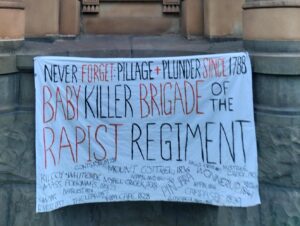
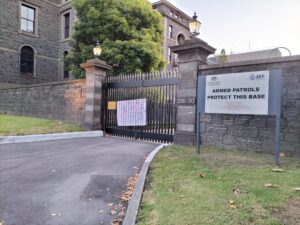
25 April 2022
How disappointing. It was a bad start to the day – I slept in and missed the ANZAC Dawn Service and March. This despite having had a relatively early night – I guess i had some catching up to do, its been a hectic weekend.
But today of all days! No matter where I am, I always try and do some kind of activity on ANZAC day, Lest We Forget and all that.
A couple of years ago we made a nice little leaflet with just that as the header- Lest We Forget. It was principally about a little known battle fought by ANZAC troops during the First World War, but put in a timeline of overseas military campaigns dating from the Boer War through to Malaya, Vietnam, and most recently Afghanistan.
Those who were lured by the faux patriotic headline were in for a surprise. Actually surprise is an understatement – shock and outrage and abuse are closer descriptions of the reaction it induced. Followed, inevitably, by denial.
Fair enough too, after all,no-one wants to find out there is a rapist in the family tree. So imagine learning there isn’t just one, but that its a multi generational tradition, your family tree is littered with rapists – serial rapists at that! Not the sort of thing they show on “Who Do You Think You Are?” or “Every Family Has A Secret”.
And the battle in question? Well for a start, the battle of the Wass’ah wasn’t really a battle, not in the military sense anyway. This appellation is merely part of the century long attempt to down play the savagery of the bloody rampage that took place in Cairo’s entertainment and red light district of the Wagh El Birket, better know as Wass’ah, over the Easter weekend in 1915.
The ANZAC troops, bored as they waited to invade Turkey and drunk in equal measure on cheap grog and racism, had done little to endear themselves to their temporary neighbors. Overwhelmed by the unfamiliarity of everything beyond their barracks gate – the language, the attire, even the geography – the labyrinth of dirty lanes so different to the wide streets of Bathurst or Bendigo, the soldier boiz hid behind macho bravado.
This couldn’t assuage the constant paranoia that the dark skinned locals were out to cheat them, but the knowledge that they wore the uniform of Empire – their Empire, the Empire that had long ago subjugated Egypt and half the world besides and was about to show Johnny Turk that the only thing an Ottoman was good for was putting your feet on! – this knowledge, it still went a long way in bolstering their self esteem and sense of privilege -after all, they hadn’t been to the front yet, so the class disparity between them and their Officers hadn’t yet shown its deadly consequences. At this point the Officers, the gentlemen, were merely toffs they, the working men, quietly made fun of behind their backs. They weren’t yet the ones who sent them to their pointless deaths, by the hundreds, thousands, at the blow of a whistle. This was still to come.
But the belligerence shown on the streets in front of their digger mates was of little use when they went up stairs and they changed one helmet for another. Alone now, the arrogance and power they feigned in the bars turned feeble.
The assertiveness of the whores intimidated them, and having little sexual experience themselves, they resented this greatly, which all to often manifested in violence against Cairo’s sex workers.
Naturally, the whores and their allies sought restitution and retribution in whatever meager way available. So a beer was watered down with piss here, a pocket picked there, or so the justification for what happened next goes…which is of course bullshit.
But enough about our leaflet. Suffice to say it went down exactly as it was intended.
But today, as I already said, we fucked up. We were so looking forward to taking our place in the ANZAC parade, with our new banner unfurled for the whole nation to see as we stopped suddenly right at the cameras relaying the pathetic spectacle on live feed for the viewing pleasure of stay-at-home patriots. Of course, how we we going to surreptitiously join the march, let alone get 2 steps with the banner before being rugby tackled from all directions – well we hadn’t really expected to succeed I guess, but we also thought it was worth trying… Now that I think it through our tardiness was probably for the best.
We ended up not getting to St Kilda Road until late in the afternoon. There was still a steady stream of people walking around near the death cult temple, but the majority seemed to be of non Anglo-European descent. Which is a good thing. I mean, an extended family of Indian origin is more likely to be confused than outraged. They might not like it if our banner pointed out how the Indian army has been used against its own people constantly since independence in 1947 – but its the truth. In one place or another, be it Andra Pradesh, Manipur, Nagaland, Punjab, Kashmir or Chhattisgarh, the Indian army has been on the streets hurting the locals daily, hurting locals since the British left**. (They even have a law that gives the soldiers cart blanche to do what they want with impunity – the notorious AFSPA- the Armed Forces Special Powers Act. Now there’s a State that looks after its troops! None of the namby pamby human rights violations bullshit the ABC has been whinging about over in Afghanistan, aint that right Bennie Boi?!***)
They might say we were being unfair, considering the history of this land. But what’s more probable is they – like the majority of the ‘Australian’ population- don’t know anything about the multitude of criminal acts committed here by the British military or that of the proto ‘Australian’ State since that tragic day in January 1788 when they first landed. Which of course is ironic since the same military was using brute force across India and much of East Asia throughout the next century and a half as it built and maintained its infamous empire.
But while your average middle-class migrant Indian family living here would be well aware of say, the Jallianwallabagh massacre or the many thousands of reprisal killings after the Indian independence uprising of 1857, they probably have scant knowledge of the massacres that have taken place all over the ‘lucky country’, or that **** rape was so common it could be the only reason full genocide wasn’t achieved in large swathes of the land. Do you think much of ‘Australia’s’ population are aware the Australian Defense Forces are still raiding communities in the Northern Territory? Still taking the children away?
Which is why our banner this year focused, at least in part, on the Frontier Wars, with the names of several dozen written across the lower section.
It read: “Never Forget: Pillage and Plunder Since 1788. Baby Killer Brigade of the Rapist Regiment. Coniston 1928, Gwydir Creek 1837, Kilcoy and Whiteside mass poisonings 1860s, Myall Creek 1838, Bathurst 1824, The Leap 1867, Mount Cottrel 1836, Gippsland 1840-50, Halls Creek 1887, Mistake Creek 1901, Pinjara 1836, Appin 1816, Campasre 1838, Wonnerupish 1841, Emurella 1840-1850” *****
Having arrived so late we decided to hang the banner on the front gate of Victoria Barracks – its hard to argue for anywhere more appropriate! But since the lighting was quite bad there, we first hung it on the old War Memorial directly opposite in the park, and had some fun draping Sir Edward Dunlop’s statue in the banner (reminiscent of the ruddy complexioned white ‘Australians’ who drape themselves in Southern Swastika Butchers Rags at summer festivals).
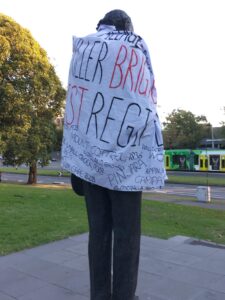
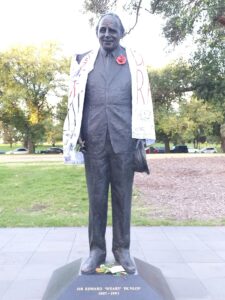
After taking some better photos there we returned the banner to the front entrance of Victoria Barracks. Despite being slightly askew it looked great, and to our surprise it was still there when we returned 20 minutes later after getting a bite to eat.
Next year we’ll try not to sleep in..
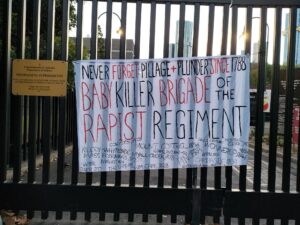
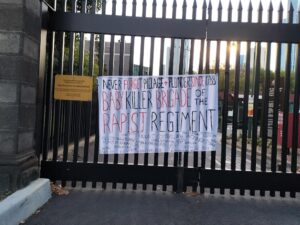
*It was, indeed, a class war, but such an analysis would have been rare and unpopular at the time, dismissed by the cannon fodder as cowardly, and as treasonous by those in command. (Meanwhile, on the streets of Melbourne and Sydney those opposed to the war faced lengthy prison sentences.) Of course anti-war sentiment amongst the troops did exist, but it has been largely and successfully written out of history wherever possible. Only when such trench talk spread and became large scale mutinies that were impossible to cover up do we learn of them – much the same as the war crimes actually.
** see Arundhati Roy
*** Ben Roberts-Smith
**** It has been suggested that the propensity of ‘Australian’ soldiers for committing war crimes such as torture and rape (that date back to their involvement in the Boer war, continuing into the Asian campaigns against the Peoples’ Insurgency in Malaya and in the counter-revolutionary war in Vietnam), can be explained by a historical culture of atrocities committed with total impunity against First Nations people during the Frontier Wars.
***** Coniston 1928 (The Coniston massacre, which took place 14 August to 18 October 1928, was the last known officially sanctioned massacre of First Nations people and significant in the Frontier Wars. In a series of punitive expeditions led by police constable William George Murray, Warlpiri, Anmatyerre, and Kaytetye people were killed. First Nations oral histories reveal that 200 people were murdered by colonialists.)
Gwydir Creek 1837 (In the summer of 1837-38, after a six week campaign which killed many Kamilaroi people, on 26 January 1838, colonialists massacred at least 40 others at Waterloo Creek, between the Namoi and the lower Gwydir Rivers).
Kilcoy and Whiteside mass poisonings 1860s (A large number of First Nations people died as the result of poisoning- deliberately administered arsenic in flour).
Myall Creek 1838 (28 unarmed First Nations people, largely women, children and old men, we slaughtered by colonists on 10 June 1838 at the Myall Creek near the Gwydir River. Children were beheaded, while older people were forced between a line of sword-wielding men who hacked at them as they passed. To the outrage of the colonial population, two trials to convict those responsible for the massacres were held, with seven of the twelve colonists found guilty of murder. Reflecting colonial sentiment, The Australian newspaper published a letter which said, “I look on the blacks as a set of monkies, and the earlier they are exterminated from the face of the earth the better. I would never consent to hang a white man for a black one”. (The Australian, 18 December 1838).
Bathurst 1824 (In 1824, the Wiradjuri people used guerrilla-style war tactics against colonialists- resultantly, there were a number of skirmishes in which colonialists murdered sixteen First Nations Wiradjuri warriors and wounded many more.)
The Leap 1867 (The massacre of 200 First Nations men, women and children took place in April 1867, after being pursued by the Queensland Native Police Force. The First Nations group were camped on land occupied by colonialists where cattle had been speared. They were forced to jump en mass off a cliff face (on Mount Mandarana) of several hundred feet, rather than be shot by the Native Police Force.)
Grim Cape 1828 (The Cape Grim massacre was an attack on 10 February 1828 in which a group of 30 First Nations people were gathering food at a beach in the north-west of Tasmania, and were ambushed and shot by four Van Diemen’s Land Company workers, with bodies of some of the victims then thrown from a 60-metre cliff.)
Mount Cottrel 1836 (The Mount Cottrell massacre involved the murder of 10 Wathaurong people near Mount Cottrell in 1836, in retaliation for the killing of two colonialists.)
Gippsland 1840-50 (The Gippsland massacres were a series of mass murders of Gunai Kurnai people committed by European settlers and the Aboriginal Police during the Frontier Wars. Between the years 1840-1850, 14 massacres occurred in and around the Gunai/Kurani area, with up to thousands of Aboriginal people murdered).
Halls Creek 1887 (A series of massacres of Djara, Konejandi and Walmadjari peoples by white gold-miners).
Mistake Creek 1901,(THe Mistake creek massacre in 1901 resulted in the murder of 200 First Nations people).
Pinjara 1836 (on 28 October 1834 at Pinjarra, a group of Binjareb Noongar people were attacked by a detachment of 25 soldiers, police, and settlers. 60 or 70 Binjareb people were attacked and 30 people were killed, including 1 woman and several children. It was “very probable that more men were killed in the river and floated down with the stream”.)
Appin 1816,(On the early morning of 17 April 1816 at least 14 people of the Dharawal tribe were killed when a colonial detachment encountered a First Nations camp at Appin near the banks of the Cataract River.)
Wonnerupish 1841, (The Wonnerup massacre, also known as the Wonnerup “Minninup” massacre, was the killing of dozens of Waadandi Noongar people by colonialists in February 1841.)
Emurella 1840-1850 (The Eumeralla Wars refer to the encounters between British colonists and Gunditjmara people. The wars lasted from the mid 1830s up until the 1860s with the most intense period being between 1834 and 1844. The Gunditjmara people mostly employed guerrilla tactics and economic warfare against the livestock and property of the British colonists, occasionally killing a shepherd or settler. The colonists utilised a wider range of strategies, such as killings of individuals and massacres of larger groups of Indigenous people, including women and children, by armed groups of whalers, settlers, station workers, and members of the Border Police and the Native Police Corps. They also used more “lawful” means such as judicial executions and the rounding up of the local First Nations people and placement of them on temporary reserves. Casualties from the conflict are estimated to be in the thousands with up to 6,500 Aboriginal deaths (based on an estimated pre-colonial contact population of 7,000 declining to just 442), and an approximate 80 deaths of colonial settlers.)